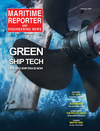
Page 33: of Maritime Reporter Magazine (February 2020)
Green Ship Technology
Read this page in Pdf, Flash or Html5 edition of February 2020 Maritime Reporter Magazine
SCRUBBERS “The chaos, volatility, and noise expected by many across the industry around fuel spreads are playing out, at least for now.”
Greg Lewis, Stock Analyst, BTIG
Approximately three weeks after January 1, 2020, the day that lower limits on sulfur in marine fuels kicked in, Kitack Lim, the Secretary General of the
International Maritime Organization (IMO) declared that the transition was a great success. In a statement, the IMO said: “Information from various sources has indicated a relatively smooth transition to the 0.50% sulfur limit. Prices for compliant fuels, very low sulfur fuel oil (VLSFO) and marine gas oil (MGO), rose quickly initially but now appear to be stabilizing.”
The economics of exhaust gas cleaning have been integral to the discussions of IMO2020, even though scrubber ? tted vessels com-
Cruise Control prise a relatively small portion of the oceangoing ? eet.
Quantum of the Seas was “According to the data from our Alternative Fuels Insight (AFI) one of the ? rst scrubber platform, the number of vessels with installed scrubbers or planned equipped cruise ships.
installations until end of December 2019 stood at 3,028,” said Mar-
Photos: RCCL tin Wold, Senior Consultant Environment Advisory at DNV GL. “However, due to the complexity of scrubber retro? ts, not all of the vessels with reported scrubber installations have hit the water yet. Looking into 2020, we expect these delayed installations will be completed and additional 800 ships with scrubbers on board will be added to the ? eet, totaling around 3,800 vessels.” The ? eet of deep sea vessels has been estimated at approxi- mately 50,000; so the proportion of scrubber ? tted vessels forecast for end 2020 is still under 10%.
The cruise sector had been an early adopter of scrubbers, starting in 2015 with the reduction of sulfur limits in ECA zones (which include cruise hubs in U.S. waters and northern Europe) to 0.1%. At the time that the cruise majors began planning for their scrubber installs, around 2012- 2013, burning high sulfur fu- els made ? nancial sense in view of high distillate (low sulfur fuels) prices and uncertain availabilities at that time. At Royal Caribbean, its Quantum of the
Seas, delivered 2014, was one of their earliest ships equipped with scrubbers.
Scrubber ? tted vessels are able burn less expensive high sulfur fuels. For ac- counting types, the “repayment” from an investment in a scrubber (with costs estimated variously at between $3 million to $5 million depending on equip- ment type and how yard time is allocated in calculations) comes from the lower cost of high sulfur fuel, compared to low sulfur blends and gasoil. The matrix below shows the impacts on repayment calculations, where the initial capital investment is repaid over time due to the advantages of cheaper fuel. The im- pacts are not uniform; a bigger vessel (consuming more tons of fuel each day) on longer voyages (more days at sea, less in port) would see a quicker payoff. www.marinelink.com 33
MR #2 (18-33).indd 33 2/5/2020 12:17:06 PM

 32
32

 34
34
